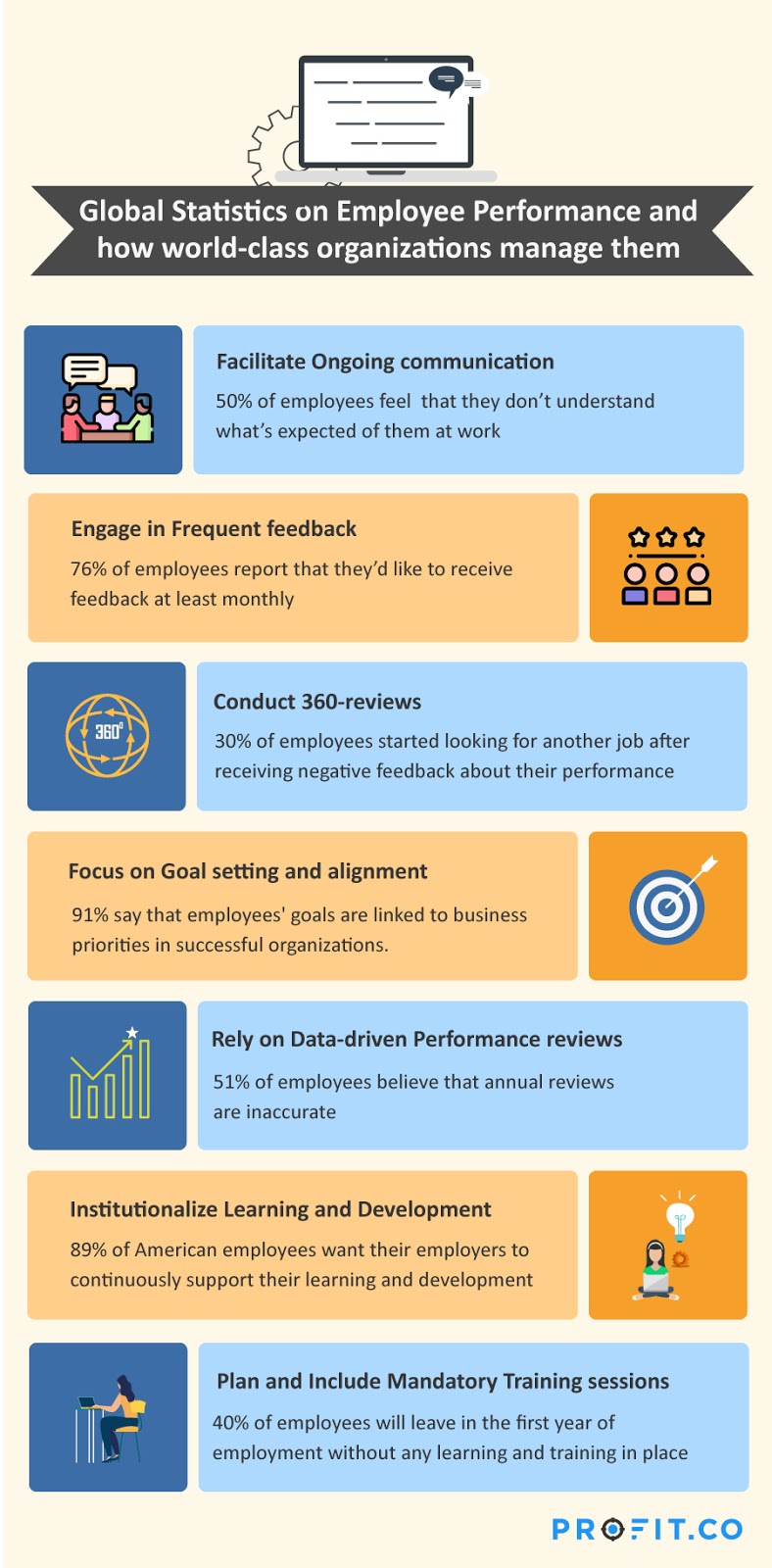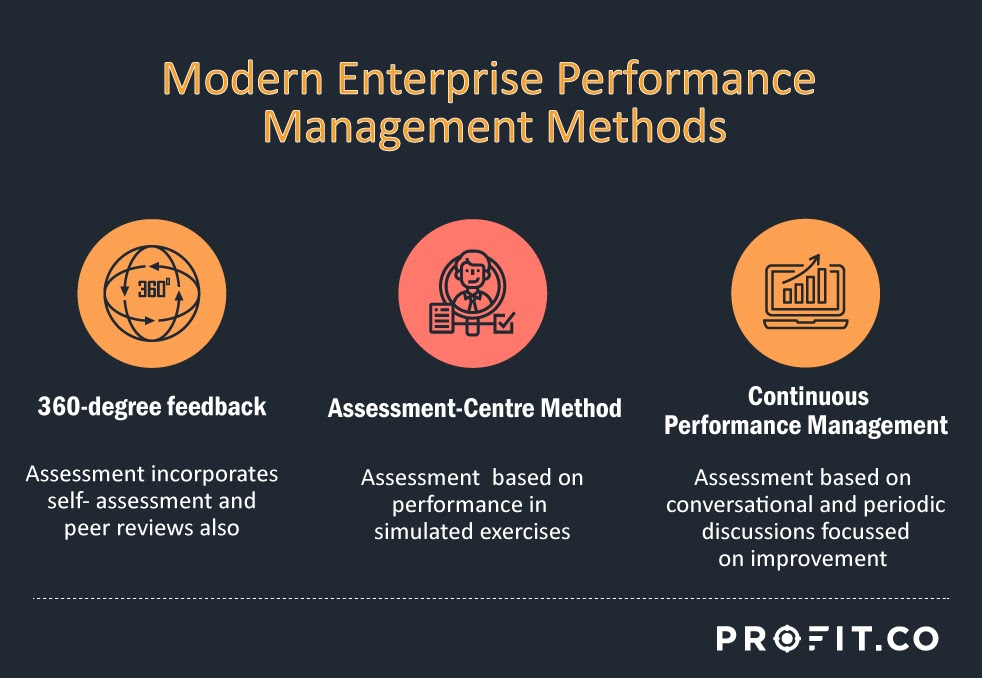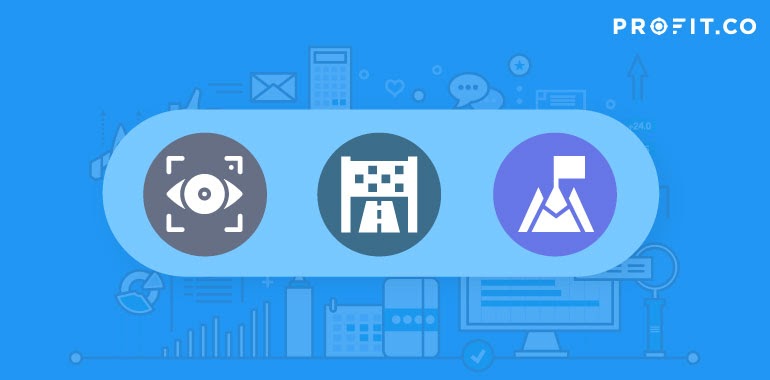For decades, organizations have relied solely upon the outdated yearly performance review as their performance management model. Despite experts as early as 1965 decrying the annual review as ineffective, it’s only in recent years that modern performance management methods have begun to replace this outdated method.
As with anything involving human psychology, there is never going to be one straight answer about effective performance management and how to best motivate your employees. What works for one employee may not work for another, and methods from one industry may not translate well to the next.
With that in mind, organizations have been working to improve their performance management process from the outdated annual review to one that is tailored to their industry and their needs.
But what do modern performance management techniques look like, and how are organizations implementing this?
Key Features of Modern Enterprise Performance Management
Good performance accountability is about having a positive conversation between manager and employee. A manager is a coach and communicator, not command and controller.
Key Features of Modern Enterprise Performance Management
An efficient performance management process is fundamentally based on three key factors:
- Communication: Communication must be ongoing and transparent
- Feedback: Feedback should be frequent and timely
- Goal-setting: Goal-setting and performance reviews go hand-in-handmance review
However, that’s not to say that when organizations are looking at performance management best practices, they don’t extend their systems beyond these three key pillars to promote effective performance. Let’s take a closer look at these three performance management essentials:
1. Ongoing communication is the hallmark of most modern enterprise performance management . With 50% of employees feeling that they don’t understand what’s expected of them at work, it just goes to show that the previous system of annual reviews and infrequent manager-employee communication isn’t working.
2. On a similar level, frequent feedback is another vital aspect of effective performance management. A study found that nearly 30% of employees started looking for another job after receiving negative feedback about their performance, meaning that any negative feedback needs to be carefully considered before it’s delivered.
3. Robust goal-setting also needs to be at the heart of performance management, as this will help to keep your employees engaged and performing at their best. Of companies that have effective performance management system, 91% say that employees’ goals are linked to business priorities. However, it’s vital that performance management systems don’t simply prescribe goals, but that managers work with employees to identify methods of improvement.

Performance reviews are still an important performance management tool, but with 51% of employees believing that annual reviews are inaccurate, performance management trends are beginning to move towards more frequent reviews or 360-reviews.
Finally, learning and training are becoming more of a highlighted feature in modern enterprise performance management plans. 89% of American employees want their employers to continuously support their learning and development, and without any learning and training in place, 40% of employees will leave in the first year of employment.Training will inevitably look different to every individual company, as will the jobs within that company, depending on the needs of both the employer and the employee. However, what all modern enterprise performance management tools have in common is that they make performance management a conversation between employees and their managers, rather than the outdated prescriptive style of annual reviews.
Modern Enterprise Performance Management Methods

With so many studies pointing towards the need to modernize performance management tools, there’s been significant growth in new performance management systems in recent years. While some companies are simply adapting their annual review process to include other performance reviews throughout the year, other organizations are changing their processes entirely.
With that in mind, you need to know about these valuable enterprise performance management methods and how they can change performance management in your organization.
3 Modern & Actionable Performance Appraisal Methods
1. 360-Degree Feedback 2. Assessment-Centre Method 3. Continuous Performance Management1. 360-Degree Feedback
One of the main drawbacks of the traditional annual review process always was that it took a very one-dimensional view of an employee’s performance, given that the assessment was conducted solely by an employee’s manager.
The 360-degree feedback process seeks to change this by incorporating peer reviews into the performance management system. By gathering feedback from an employee’s coworkers and other contacts within the organization, managers can gain a better understanding of how well their employees are performing.
It’s an unfortunate truth that individual bias can come into play when a manager is a sole person responsible for performance reviews, which is why 360-degree feedback improves the review process for employees as well as managers.
In a 360-degree feedback process, there are four key circles of influence that are assessed and used to form a rounded report on an employee’s performance. These are:
1. Personal: Employees are usually asked to fill out a self-assessment form regarding their performance over a set period. They may also be asked to fill out a Subordinates Appraising Manager (SAM) to evaluate their manager’s performance and how it’s affected them.
2. Managerial: An employee’s manager fills out a performance review for the employee.
3. Peer: An employee’s manager sends an anonymous survey to an employee’s coworkers or other employees they have frequent contact with.
4. Customer/Client: If applicable and appropriate, customers or clients that have spoken with the employee may also be asked to fill out a survey about their performance.
Once this information has been collected, it’s then anonymized and given to the employee as feedback in a traditional-style performance review. Then, you and your employee will agree on a series of goals that you’ll form based on this feedback.
Advantages of 360-Degree Feedback
Reduces bias: By involving multiple people in the review process, it greatly reduces the chance of a single biased person giving an employee an unfair review.
Self-assessment: Encourages employees to think critically about their performance and how it affects their peers.
Promotes engagement: Employees get a more rounded view of their performance, so they’re more likely to hear how they’ve performed well as well as where they need to improve.
Problems with 360-Degree Feedback
Potential for competitiveness: If 360-feedback reviews are tied to financial and promotional decisions, competitive employees may decipher who they are asked to review and give unfair feedback.
Lengthy process: This performance management system works best when conducted multiple times a year, which can make it time-consuming.
Where Does 360-Degree Feedback Work?
Organizations that promote community and communication will benefit from 360-degree feedback as peer reviews are likely to be more well-rounded. This process also works best in organizations that don’t make financial and promotional decisions based on employee performance management feedback alone.
Who Uses 360-Degree Feedback?
Technology big brand, Philips, implemented 360-degree feedback to improve how they worked on developing their employees. As a result, they found that managers were more able to implement action points from the reports, and participants liked that the new framework meshed with their company goals.
2. Assessment-Centre Method
The traditional performance review system was never well-suited for industries such as manufacturing in which employees need to be measured by their physical competencies. That’s where the assessment-center method comes in.
Using this method, employees are assessed based on their performance in simulated exercises, such as role-play, fact-finding exercises, physical problem-solving, or informal discussions. This assessment is then fed back to the employee, and the employer evaluates as to whether they need additional training or other support.
The assessment-center method works in three key stages.
In the pre-assessment stage, you have to determine what assessments you’ll use. Remember that these should be a reflection of what skills an employee needs to succeed in the role. You then devise a rating system, find assessors, and train them (if necessary) on what to look out for.
The assessment stage is where managers invite their employees to conduct your chosen exercises to be assessed on their performance. You should make sure that you and your assessors also note their strengths and weaknesses.
Finally, during the post-assessment stage, the manager evaluates the results for their professional validity before they present them to their employee. In a standard performance management review, managers and their employees set goals for the future, as well as talk about any training or development that may be needed.
Advantages of the Assessment-Centre Method
Technical review: This method allows managers to see how employees work during tasks that they may not normally witness on a day-to-day basis.
Personality insight: Managers get to see more of an employee’s personality in how they deal with pressure, make decisions, etc.
Adaptability: With a wide range of different assessments, this method is easy to adapt to multiple job roles and industries.
Problems with the Assessment-Centre Method
Time-consuming: It can easily take a full working day to assess a single employee.
Hawthorne Effect: Because the employee is being watched, they might behave and perform differently to please the assessors. This makes this method less accurate for determining performance.
Where Does the Assessment-Centre Method Work?
This method works best for manufacturing roles where employees need to be tested on their physical competencies. However, it’s also been used in the education and consultation industries to identify candidates for promotion.
Who Uses the Assessment-Centre Method?
Major organizations like Microsoft and AT&T have started using the assessment-centre method to evaluate their employees for future leadership potential.
3. Continuous Performance Management
What is the continuous performance management Method?Traditional annual reviews have long been criticized as an enterprise performance management tool because employees don’t get feedback on their performance regularly enough to effect meaningful change.
Continuous performance management is a new method in which the annual performance review cycle is sped up, meaning managers and employees will regularly meet multiple times each year to discuss an employee’s performance and how they can improve. This often varies between companies, with some opting to do a primary review once a year and treat interim reviews as a chance to catch up with employees and keep them on track.
This method has become particularly popular with agile companies that want to implement modern performance management tools as part of their daily operations.
Advantages of Continuous Performance Management
Regular feedback: Employees get to talk about their performance regularly, allowing them to collect feedback promptly. Templates for these reviews are here.
Staying on track: Employees can bring any concerns to their manager as they happen, ensuring that they can stay on track with their goals.
Improves engagement: Regular feedback helps to keep employees engaged, which leads to greater productivity and lower employee turnover.
Problems with Continuous Performance Management
Not always applicable: This method can’t always be translated into more physical industries like manufacturing and construction.
Where does Continuous Performance Management Work?
As mentioned earlier, agile companies that value collaboration and constant growth will benefit greatly from the continuous performance management process. Also, organizations that are struggling with high employee turnover and low employee morale will see major improvements in their employees with this method.
Who Uses Continuous Performance Management?
Adobe is the most well-known adopter of continuous performance management as they adopted it relatively early in 2012. Since then, this method has been adopted by other large companies like IBM, Deloitte, and even General Electric.
Profit.co and Performance Management
Profit.co’s performance management module can support any performance management style your company chooses to implement. Profit.co’s suite of flexible features enables HR administrators to initiate performance reviews as frequently as they want as well as add peer reviewers, external reviews, and managerial reviews. The software supports performance reviews rooted in rating competencies, or skills, as well as reviews that rely on employees to answer open-ended questions. These are completely customizable, so HR administrators can tailor the review as specifically as they would like depending on the employee’s seniority level, job role, and department. With Profit.co’s numerous options for effective performance reviews, assessing employees has become easier and more comprehensive than ever before, and can seamlessly integrate into your company’s culture. To learn more about Profit.co’s agile performance management module, book a free demo today!Top Enterprise Performance Management Methods: In Summary
Despite being a popular performance management tool from the past few decades, the annual review has been shown by numerous studies to be ineffective at best and harmful to your organization at worst. Thankfully, as more companies have realized this, there are increasingly more modern performance management systems that will help your organization to improve employee performance, reduce turnover, and even increase profits.
Performance management tools like the 360-degree feedback system, the assessment-centre method, and continuous performance management have become more commonplace as more studies show the benefits of regular employee feedback. However, that’s not to say that these tools will always be suitable for every industry. With that in mind, it’s important to understand the benefits and drawbacks of each performance management process so you can determine whether it’ll help your employees and your organization.




